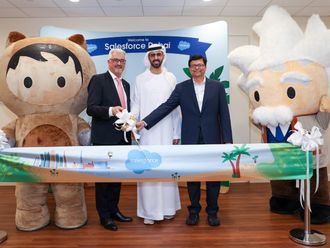Scientists working to reduce agricultural water consumption are bringing new grasses into commercial production.
Take the Dhaid highway and you pass a frontline in the Middle East's struggle against the desert.
| Tracy Brand/Gulf News "These grasses use 30 per cent less water than current fodder crops," says Dr Ahmad Osman (left), with a colleague of the International Centre for Agricultural Research in Dry Areas, Dhaid area. |
In the space of a few miles you will see date farms at every stage of their apparently inarrestible progress from verdant grove to grid of stumps — the point by which the farmer will have already started the whole process again elsewhere.
The cycle is accelerating. Farmers must now bore deeper to extract water. Yet the aquifers continue to run dry or turn brackish, poisoning both the crops and the land.
After several years when the rains stayed away, the journey from planting to abandonment can now be complete in a few years.
Yet this bleak trend may not be inevitable. At a research station a few hundred yards from the highway five hectares of grass offer a new tool in cutting the 80 per cent of the UAE's water supply expended on agriculture.
Harvesting the florets takes a dustpan and brush and a lot of patience. Extracting the seeds requires custom-built machinery. |
From here, in facilities provided by the Ministry of Agriculture and Fisheries, Dr Ahmad Osman seeks more sustainable agriculture.
"Where I was brought up there was plenty of water," says the Sudanese expert, who spent his youth on a smallholding by the Nile.
"But in this region, the whole concept is combating desertification — the degradation of the land by agriculture."
Use of water
"Agricultural produce used to be subsidised in the UAE," says Esmail Hussain Mohammad of the Ministry of Agriculture and Fisheries Central Agricultural Region.
"Now we subsidise veterinary services and we focus on promoting responsible water-use rather than on production."
| These grass offer a new tool in cutting the 80 per cent of the UAE's water supply expended on agriculture. |
One drive is irrigation technology. Across the UAE water channels and sprinklers systems are being gradually phased out. In their place snake the black plastic tubes of modern drip-irrigation.
"To encourage their use we make modern systems available at half the market price," says Mohammad. "In parts of the UAE their use is legally enforced."
But Dr Osman's biggest headache is not watering plants but feeding animals.
"The initial problem," says Dr Osman, "is the excess of all types of animals across the Middle East. The free range is no longer sufficient to feed these herds".
"The standard forage crop in the UAE is alfafa," says Dr Osman. "However, this is not because it is especially suited to local conditions — in fact it requires quite heavy irrigation. Farmers grow it because its seeds are freely available in the market."
"Livestock consumes around 70 per cent of the water employed in agriculture," says Osman.
"In the summer, four cubic metres of water are necessary to produce one kilogram of dry matter. A sheep gets through that in a day."
This is where the meadow comes in. It is the culmination of years of research to find the UAE's crop idol — a grass with minimal thirst.
In 1998 Dr Osman and his team started collecting local grasses and interviewing farmers on which their herds preferred. The field contains the four winning species — whittled down from 168 candidates.
Selected plants
The four successful contestants are cenchrus ciliaris, coelachyrum piercei, lasiurus scindicus and panciun turgidun.
Two of these are catnip to camels, the other pair to goats and sheep. All are also capable of surviving the research station's most brutal harvesting and water-deprivation regimes.
Selecting these plants, however, was the easy bit. As none had ever been cultivated here, extracting their seed was a challenge of extreme fiddliness.
Take cenchrus ciliaris. Rather than producing a convenient head of grain, it sprouts miniscule seeds of less than a thousandth of a gram hidden in a hairy spiklet.
Harvesting the florets takes a dustpan and brush and a lot of patience. Actually extracting the seeds requires a custom-built machinery.
An Australian expert built the contraption to convert the bulging sacks of florets into a tiny plastic sachet of seed — a mere palmful of which, however, are sufficient for acres of land.
But Dr Osman is delighted that demand for his supergrasses already outweighs supply. In January they first began to appear on MAF Central Region farms. Now the transition from government farms to private holdings is underway.
"These grasses use 30 per cent less water than current fodder crops," says Dr Osman.
"Farmers tend to be conservative, but when the word spreads that these grasses can extend the life of farms, we are going to generate interest. Now we have introduced the idea, I am sure commercial production of these seeds will follow."












